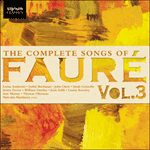This is Fauré’s last song in madrigal style, but one of the most piquant. It would surely be better known if an accident of publishing had not consigned it to be issued as a single song by a new publisher, Heugel (another ‘orphan’ song which shares this fate is
Le don silencieux). The text comes from Henri de Régnier’s collection
La sandale ailée, hot off the press. It is possible that Fauré was drawn to the poet by the example of Albert Roussel, four of whose settings of Régnier’s poetry were performed by Jane Bathori in Paris in April 1906; the same singer was to perform
La bonne chanson the following month at an all-Fauré festival. The title is the poet’s own, a kind of compliment galant in the manner of the first of Ravel’s
Don Quichotte songs. Paradoxically the extravagant tone of the words gives them a courtly formality. Régnier’s pastiche of a madrigal is matched by Fauré with similar time-travel; his song is accompanied by a piano standing in for a lute, and that instrument is depicted with more accuracy than in
Clair de lune.
Chanson is rightly prized by those who admire musical economy – this is a fine example of
multum in parvo, a piece of musical conjuring where the most slender means achieve eloquence. Indeed this song is typical of many a creation from Fauré’s third period, a substantial achievement that only masquerades as a trifle. Notes used with sparing discernment, a strong bass line and an implacable rhythm create a harmonic world of subtlety and disguised richness. The change from E minor into the four sharps of E major is a masterclass in modulation. Nadia Boulanger, that great teacher of composition and Fauré’s pupil at one time, doubtless adored
Chanson. It is no coincidence that the music of many of her pupils, including the young Lennox Berkeley, aspired to this lean texture with never a note too many. Astonishingly, this music has the characteristics of Stravinsky’s neo-classicism before Stravinsky himself had discovered any such style. When this happened Fauré has already moved on to pastures, or gardens, more rarefied still.
from notes by Graham Johnson © 2005
Cette ultime mélodie de Fauré en style madrigalesque – l’une des plus piquantes, aussi – serait sûrement mieux connue si un incident éditorial ne l’avait contrainte à être publiée toute seule par un nouvel éditeur, Heugel (un sort qu’elle partage avec une autre mélodie «orpheline»,
Le don silencieux). Le texte est extrait du recueil de Henri de Régnier intitulé
La sandale ailée, alors tout frais sorti des presses. Peut-être Fauré a-t-il été amené à ce poète par le biais d’Albert Roussel, qui l’avait mis en musique à quatre reprises dans des mélodies chantées par Jane Bathori à Paris, en avril 1906 – la même interprète devait donner
La bonne chanson le mois suivant, lors d’un festival Fauré. Le titre est celui du poète, une sorte de compliment galant à la façon de la première mélodie du
Don Quichotte ravélien. Paradoxalement, leur ton extravagant confère aux mots une certaine formalité courtoise. Au pastiche d’un madrigal choisi par Régnier, Fauré répond par un voyage dans le temps: sa mélodie est accompagnée par un piano qui tient lieu de luth, brossé ici avec plus de justesse que dans
Clair de lune.
Chanson est prisée, à juste titre, des admirateurs de la parcimonie musicale, qui y voient un bel exemple de
multum in parvo, de prestidigitation musicale où les moyens les plus ténus atteignent à l’éloquence. Cette mélodie est en effet typique de maintes créations du Fauré troisième manière: une réalisation substantielle qui se fait passer pour une simple broutille. Notes utilisées avec un discernement parcimonieux, forte ligne de basse et rythme implacable forgent un univers harmonique tout en subtilité et en richesse dissimulée. Le passage du mi mineur aux quatre dièses du mi majeur est un coup de maître de la modulation. Nadia Boulanger, grand professeur de composition qui fut un temps élève de Fauré, adorait très certainement
Chanson. Et ce ne fut pas un hasard si la musique de nombre de ses disciples, dont le jeune Lennox Berkeley, aspira à cette minceur de texture, sans jamais une note de trop. Aussi étonnant que cela paraisse, cette musique présente les caractéristiques du néoclassicisme stravinskien avant même que Stravinski eût découvert un style de ce genre. Lorsqu’il le fit, Fauré, lui, était déjà passé aux patûres ou aux jardins, encore plus épurés.
extrait des notes rédigées par Graham Johnson © 2005
Français: Hypérion


 Fauré: The Complete Songs, Vol. 3
Fauré: The Complete Songs, Vol. 3
